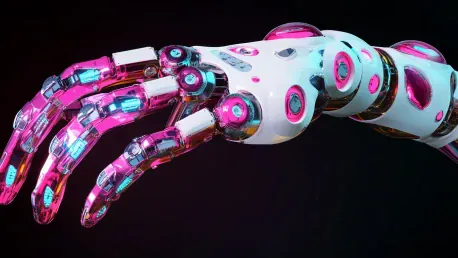The notion that robotic collectives could transform into smart, adaptive materials isn’t merely a futuristic fantasy. Researchers at UCSB, led by Matthew Devlin and guided by Professor Elliot Hawkes, have made significant strides in this direction. Their innovative work, which draws inspiration from the dynamic and adaptive characteristics of living systems, aims to engineer robotic collectives capable of tunable shape and strength. The research, documented in the journal Science, involves creating a system of disk-shaped autonomous robots that collectively form materials with the ability to dynamically change shape and physical properties.
Creating Dynamic Robotic Materials
Inspiration from Biology
At the core of this groundbreaking research lies the ambition to create robotic materials that exhibit both rigidity and adaptability. These materials need to be strong and rigid, yet capable of fluidly transitioning into new shapes when necessary. This concept, known as rigidity transition, is inspired by the way embryonic cells switch between fluid and solid states to shape an organism. A fundamental challenge in recreating this biological phenomenon within robotic systems involved enabling robots to attach firmly to each other, as well as configuring them to detach and move freely when a new shape is required.
Embryonic tissues provided an invaluable biological blueprint for the researchers. In embryos, undifferentiated cells transform into highly structured parts, such as hands and feet, through complex mechanisms of self-shaping, self-healing, and controlled material strength. These processes are driven by mechanisms such as cell-cell adhesion, regulated by biochemical signals, and the application of active forces by cells to reorganize the tissue. By borrowing these concepts, researchers aimed to develop robotic units that could mimic these adaptive behaviors, forming a collective that transforms based on situational demands.
Robotic Units and Mechanisms
In their pioneering system, UCSB researchers utilized magnets to imitate the cell-cell adhesion seen in biological entities. These magnets, embedded around the perimeter of each disk-shaped robotic unit, enable the robots to adhere to one another, forming a cohesive collective material. To replicate the action of biologically active forces, the robots were equipped with motorized gears that apply tangential forces similar to inter-cellular forces in biological tissues. By controlling these forces meticulously, researchers succeeded in allowing the robotic units to reshuffle and reconfigure as a unified entity.
The development of these robotic units involved addressing various engineering hurdles, such as maintaining balance between the attachment and detachment forces, ensuring seamless communication between units, and achieving coordinated movements. These tiny robotic entities, acting in harmony, possess the potential to create a new generation of mechanical materials that dynamically adapt to their environment. This could enable them to transition between solid and flexible states, tailoring their properties based on specific applications and requirements.
Transitioning Between States
Modulating Forces
The transition between different states within the robotic collectives is regulated through the modulation of inter-unit forces. By controlling these forces, researchers can prompt the robots to adhere firmly and function as a solid material. Conversely, activating dynamic forces allows the collective to fluidize, enabling it to flow and reconfigure into new shapes. This process of dynamic modulation empowers the robotic materials to support heavy loads, alter their shape as required, manipulate objects, and even self-heal when disrupted. The ability to shift between these states efficiently makes these materials particularly promising for a wide range of applications.
One of the significant advantages of using this force modulation technique is its ability to influence the collective behavior without the need for direct human intervention. The robots can autonomously respond to environmental changes, such as temperature fluctuations or mechanical stresses, making them highly versatile. This autonomous adaptability reflects the natural processes observed in biological systems, where cells inherently know when and how to switch states to perform specific functions.
Light Sensors for Coordination
In addition to force modulation, UCSB researchers incorporated light sensors equipped with polarized filters to aid the spatial orientation and coordination of the robots. By exposing these sensors to light, the robots receive directional commands, akin to how biochemical signals guide cellular activities in living organisms. This enables the robotic collective to align and function as a cohesive unit, achieving desired configurations through precise coordination. The light-based signaling system allows the robots to communicate their positions and collectively determine the optimal shape and structure for various tasks.
This innovative use of light sensors highlights the potential for integrating advanced technologies within robotic systems. As robotics continues to evolve, incorporating elements conducive to effective communication and coordination enhances the collective’s ability to perform complex tasks. Moreover, this light-based approach opens up possibilities for more intricate and responsive behaviors, offering a glimpse into the future of smart materials and adaptive robotics.
Future Potential and Applications
Proof-of-Concept and Scalability
The current proof-of-concept for these robotic ensembles involves a limited number of relatively large units, around 20 in total. Despite the small scale of the initial demonstration, simulations suggest that the system can be scaled up significantly to include thousands of miniaturized units. This scalability points to the potential for developing advanced robotic materials capable of assuming myriad shapes and adjusting their physical attributes on demand. As technology progresses, such materials could revolutionize numerous fields by challenging the conventional understanding of material objects and their applications.
The concept of massive scalability also brings to the forefront potential applications in areas where adaptability and dynamic characteristics are critical. Imagine building structures that can adjust their properties based on the load or external environmental conditions, or medical devices that change shape to conform to the human body. The possibilities are vast, limited only by the imagination and the extent to which these principles can be applied effectively.
Broad Applications
The idea of robotic collectives evolving into smart, adaptive materials is no longer just a science fiction trope. At the University of California, Santa Barbara (UCSB), researchers led by Matthew Devlin and under the mentorship of Professor Elliot Hawkes have made notable advancements in this area. Their groundbreaking research derives its conceptual framework from the dynamic and adaptive nature of living organisms. The primary goal is to create robotic collectives with the capability to modify their shape and strength as needed. This pioneering work, which has been featured in the prestigious journal Science, involves developing a network of disk-shaped autonomous robots. These robots work together to form materials that can dynamically alter their shape and physical properties. This breakthrough not only holds promise for advancing robotics but also for creating materials that can adapt to a variety of tasks and environments, opening up new possibilities for engineering and technology.









